List of presidents of the United States by military rank
Appearance
This article has multiple issues. Please help improve it or discuss these issues on the talk page. (Learn how and when to remove these messages)
|
The United States Constitution names the president of the United States the commander-in-chief of the United States Armed Forces. Many presidents, however, also served in the military before taking office. All but 13 of the 45[a] persons to become president have served.
Of the 32 presidents with military service, 31 have been commissioned officers, of whom five began their careers as regular officers (Jimmy Carter transferred to the Navy Reserve after five years in the Navy). There have been 13 presidents who held general officer rank (four regular officers, six militia officers, three volunteers).
Table of United States presidents by military rank
[edit]General of the Armies
[edit]| Rank order | Highest rank | Branch | President | Service experience | Service notes |
|---|---|---|---|---|---|
| 1 | No official insignia[b] | Virginia militia (1752–1758) (1775–1783)[1] United States Army (1798–1799)[2][page needed] |
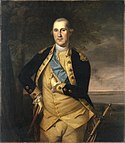 |
French and Indian War (1754–1758)[d][4][page needed][5][page needed] War for Independence (1775–1783)[e][6][page needed][7][page needed] Whiskey Rebellion (1791–1794)[8][page needed][9][page needed] - Thanks of Congress |
|
 (Regular Army) |
 |
Mexican–American War Civil War - Thanks of Congress |
Graduated West Point; first Lieutenant General since Washington, appointed as four-star General of the Army of the United States in 1866. In 2022 Grant was promoted by the United States Congress to General of the Armies to celebrate the 200th anniversary of his birth. The rank of General of the Armies is considered senior to General of the Army. Grant became the third person to become General of the Armies after John J. Pershing and George Washington. Grant and Pershing are outranked only by Washington. |
General of the Army (Special grade)
[edit]| Rank order | Highest rank | Branch | President | Combat experience | Service notes |
|---|---|---|---|---|---|
| 2 |  General of the Army |
 (Regular army) |
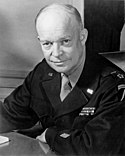 |
Supreme Commander of the Allied Invasion of Europe, primarily the Battles for Normandy, France and Germany World War II. - Army Distinguished Service Medal (5) Navy Distinguished Service Medal |
Graduated West Point; served 1915–1952, resigned to run for president. Commission and rank restored by Congress in 1961. Commissioned but inactive until death. Served stateside during World War I and as Supreme Allied Commander during World War II. |
Major general (O-8)
[edit]| Rank order | Highest rank | Branch | President | Combat experience | Service notes |
|---|---|---|---|---|---|
| 3 |  Major General |
 North Carolina Militia Tennessee Militia |
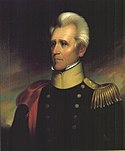 |
Revolutionary War Creek War War of 1812 First Seminole War. - Thanks of Congress |
Served at age 13 as a militia messenger during the Revolutionary War; was captured, becoming the only president to have been held as a prisoner of war (Washington had surrendered in the French and Indian War but was immediately paroled); served in the War of 1812, attaining the rank of major general and became a national hero after his success at the Battle of New Orleans. |
 |
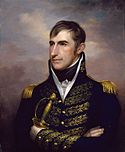 |
Northwest Indian War War of 1812 - Thanks of Congress |
Dates of service: 1791–1798, 1812–1814. Became national hero after success at the Battle of the Thames. | ||
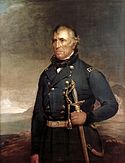 |
War of 1812 Black Hawk War Second Seminole War Mexican–American War - Thanks of Congress |
Became a national hero because of his achievements in the Mexican–American War. | |||
Major General of Volunteers |
 (volunteers) |
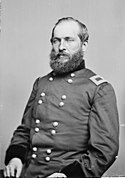 |
Civil War | His heroic ride at the Battle of Chickamauga later helped him to be elected president. | |
 Major General |
American Red Cross (Under jurisdiction of the US War Dept) |
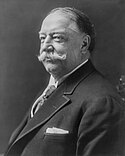 |
None | He was Secretary of War under President Theodore Roosevelt from 1904 to 1908. Taft also joined a Connecticut Home Guard unit during World War I. He was commissioned with military rank in the American Red Cross by President Wilson August 1917[12] |
Brigadier general (O-7)
[edit]| Rank order | Highest rank | Branch | President | Combat experience | Service notes |
|---|---|---|---|---|---|
| 4 | Brigadier General |
 New Hampshire Militia |
 |
Mexican–American War | Served in New Hampshire Militia from 1831 to 1847 and attained the rank of Colonel. Appointed to command 9th Infantry Regiment during Army expansion for Mexican–American War. Subsequently, promoted to Brigadier General and command of a brigade. |
New York State Militia |
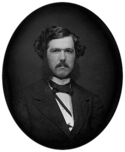 |
Inspector General of the New York Militia – Civil War |
Joined militia as Judge Advocate of 2nd Brigade. Appointed Quartermaster General on Governor's staff, and later appointed Inspector General. Offered command of brigade raised in New York City, but Governor declined to allow him to leave state service. Left service in 1863 after new Governor appointed a successor. | ||
 |
 |
Military Governor of Tennessee – Civil War |
Served in the 90th Regiment of Tennessee Militia in 1830s. Later appointed Colonel. | ||
 (volunteers) |
 |
Civil War | Successful leadership in Virginia/West Virginia region; wounded at the Battle of South Mountain. Later appointed Brevet Major General. | ||
 Indiana State Militia |
 |
Civil War | Battle of Perryville Atlanta Campaign Battle of Nashville |
Colonel (O-6)
[edit]| Rank order | Highest rank | Branch | President | Combat experience | Service notes |
|---|---|---|---|---|---|
| 5 | Colonel |
 Albemarle County |
 |
None | Like other Virginia gentlemen, he had militia duties, and did administrative work |
Orange County |
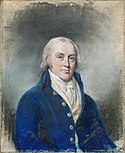 |
None | Left militia to enter Virginia legislature. (Some sources claim Madison briefly assumed command of an artillery battery during the British assault on Washington during the War of 1812. If true, he would join Washington (Whiskey Rebellion) as having seen military service as commander-in-chief.) | ||
Virginia State Militia |
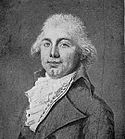 |
Revolutionary War | Dates of service: 1776–1779. Wounded and nearly died in the Battle of Trenton. Returned to Virginia to recruit and lead a regiment as a militia Lieutenant Colonel, but the regiment was never raised. Commissioned as a Colonel during the British invasion of Virginia in 1780 to command the militia raised in response and act as liaison to the Continental Army in North Carolina. Appointed As Secretary of State during the War of 1812, scouted and deployed troops during the British invasion of Washington. | ||
| Tennessee Militia |  |
None | Captain in a cavalry unit beginning in 1821. Subsequently, appointed Colonel on staff of Governor William Carroll. | ||
 |
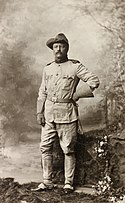 |
Spanish–American War – Medal of Honor (posthumously; 2001) |
Commissioned as a Second Lieutenant in the New York National Guard's 8th Regiment in 1882. Company commander with rank of Captain when he resigned in 1886. Famous for charge up San Juan Hill. Posthumously awarded the Medal of Honor. As ex-president, volunteered for service in World War I, but President Wilson declined. | ||
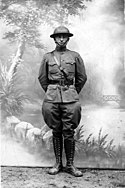 |
World War I - Armed Forces Reserve Medal (2) |
Served 1905–1911, then in World War I, 129th Field Artillery (1917–1919), Army Reserves (1919–1953)[13] |
Commander (O-5)
[edit]| Rank order | Highest rank | Branch | President | Combat experience | Service notes |
|---|---|---|---|---|---|
| 6 | 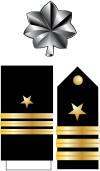 |
 (Reserve) |
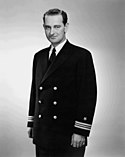 |
World War II – Silver Star Medal |
Awarded Silver Star by General Douglas MacArthur for his role as an observer on a Martin B-26 Marauder bomber mission. This award has been the subject of controversy.[14][15][16][page needed][17] |
 |
World War II - Navy and Marine Corps Commendation Medal |
Served 1942–1945 on various islands in the South Pacific and commanded SCAT units in the South Pacific. United States Naval Reserve (1946–1966).[18] |
Major / Lieutenant commander (O-4)
[edit]| Rank order | Highest rank | Branch | President | Combat experience | Service notes |
|---|---|---|---|---|---|
| 7 | Major |
New York State Militia |
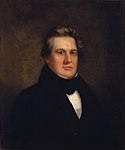 |
None | Years of service: 1820s–1830s, 1860s–1870s |
Brevet Major |
 (volunteers) |
 |
Civil War | Served in the Army of the Potomac, originally with the 23rd Ohio Infantry, the same unit as President Rutherford B. Hayes. First major engagement in West Virginia in 1861 and was present at the surrender of the Army of Northern Virginia. | |
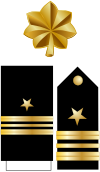 Lieutenant Commander |
 (Reserve) |
 |
World War II - American Campaign Medal Asiatic–Pacific Campaign Medal |
Years of service: 1942–1946. Served on USS Monterey. Earned 10 battle stars.[19][20] |
Captain / Lieutenant (naval) (O-3)
[edit]| Rank order | Highest rank | Branch | President | Combat experience | Service notes |
|---|---|---|---|---|---|
| 8 |  Captain |
 |
 |
War of 1812 | Raised a company for the defense of Richmond in 1813 |
 |
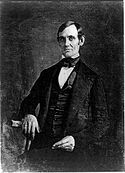 |
Black Hawk War | Initially elected to command a company as a captain. Was mustered in and out of service during the Black Hawk War, going from Captain to Private and finishing his service in an independent spy company commanded by Captain Jacob Early. Honorably discharged without seeing combat. Also served in Stillman's Run and the Battle of Kellogg's Grove. | ||
 (Reserve) |
 |
None | Served as a second lieutenant in the U.S. Army Reserve; served in the United States Army Air Forces during World War II, attaining the rank of captain. Was barred from combat because of poor eyesight. Narrated pre-flight training films under the Army Air Forces Motion Picture Unit. | ||
 Lieutenant |
 (Reserve) |
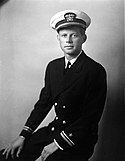 |
World War II – Navy and Marine Corps Medal |
Commanded a PT boat. Earned Navy and Marine Corps Medal for heroism in the PT-109 Incident.[21] | |
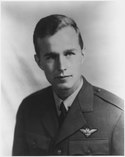 |
World War II – Cross |
Years of service: 1942–1955 (on active service 1942–1945). Second[22] youngest pilot in the United States Navy during World War II (Three days before turning 19).[23] Earned Distinguished Flying Cross. | |||
 |
World War II - China Service Medal |
Years of service: 1946–1961 (on active service 1946–1953). Graduated 59th in class of 1946 out of 820, United States Naval Academy at Annapolis, Submarine service (Nuclear Specialist). Midshipman during World War II, served during the Korean War, but never sent to Korea |
First lieutenant (O-2)
[edit]| Rank order | Highest rank | Branch | President | Combat experience | Service notes |
|---|---|---|---|---|---|
| 9 | |||||
 First lieutenant |
 (Air National Guard) |
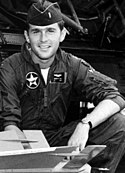 |
None - Air and Space Outstanding Unit Award |
He performed Air National Guard duty as an F-102 pilot through April 1972, logging 336 hours, when he lost his authorization to be a pilot for failing to meet attendance and physical examination requirements.[24] He was later discharged eight months short of his six-year service requirement.[25] |
Private
[edit]| Rank order | Highest rank | Branch | President | Combat experience | Service notes |
|---|---|---|---|---|---|
| 10 | Private |  Pennsylvania National Guard |
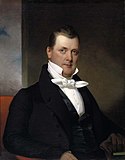 |
War of 1812 | Joined volunteer light dragoon unit and served in defense of Baltimore. Only future president with military service who did not serve as an officer. |
Did not serve
[edit]| President | Service notes |
|---|---|
| John Adams | Adams was 41 years old when the Revolutionary War broke out and did not serve in the field. In addition to his diplomatic duties during the war, he served an executive role in managing the distribution of ammunition and other supplies for the Continental Army and coordinating strategic communication among the generals of the various theaters. He is sometimes called the "de facto Secretary of War" during this time. |
| John Quincy Adams | The U.S. did not fight any major wars during the time when Adams was of the usual age for military service (18 to 33) and the peacetime armed forces were very small during this time. It would not have been expected for a member of a prominent, wealthy family to serve unless a war broke out. |
| Martin Van Buren | Van Buren was a member of the New York state senate when the War of 1812 began and was involved in the military justice system and on issues of military administration during the war. |
| Grover Cleveland | Drafted during the Civil War, but paid $150 for a substitute (a legal option under the terms of the Enrollment Act of 1863, and his substitute survived the war). |
| Woodrow Wilson | The U.S. did not fight any major wars during the time when Wilson was of the usual age for military service (18 to 33) and the peacetime armed forces were very small during this time. Wilson was in his mid-40s and working as a professor at Princeton during the Spanish-American War. Moreover, his poor health (he had experienced a minor stroke in 1896),[26] would have disqualified him from any active service. |
| Warren G. Harding | Harding was a 33-year-old member of the Ohio state senate when the Spanish-American War broke out. |
| Calvin Coolidge | Coolidge was 26 years old, practicing as an attorney, and serving as a city council member when the Spanish-American War broke out. |
| Herbert Hoover | Served in a private humanitarian capacity as a civilian in Europe during World War I. He was also involved in the Siege of Tientsin during the Boxer Rebellion as a guide for U.S. Marines. |
| Franklin D. Roosevelt | Attempted to join the Navy during the Spanish–American War but was unable as he contracted measles. Served as Assistant Secretary of the Navy from 1913 and through World War I; when the U.S. entered the war in 1917 he offered his resignation so that he could apply for a commission in the Navy, but was refused by the president. However he did visit the Western Front 1918. |
| Bill Clinton | Received a 2-A student draft deferment during the Vietnam War, and later registered for the draft. He received a high draft number, was not drafted and did not serve. |
| Barack Obama | Reached age 18 in 1979, six years after the end of the military draft in the U.S. |
| Donald Trump | Attended New York Military Academy for secondary school, graduating in 1964. Received four draft deferments while attending college, then one for medical reasons after he was diagnosed with bone spurs on his heels.[27] |
| Joe Biden | While in school, received five student draft deferments and afterward was classified as unavailable for military service due to asthma. |
See also
[edit]Notes
[edit]- ^ As of 2021[update]. While there have been 46 presidencies, only 45 individuals have served as president: Grover Cleveland served two non-consecutive terms and is numbered as both the 22nd and 24th U.S. president.
- ^ Only person that received the rank while still on active service, John J. Pershing, only ever wore 4 silver stars like other 4-star generals.
- ^ See Military career of George Washington for additional information.
- ^ Washington attained the rank of colonel in the French and Indian War; see George Washington in the French and Indian War for additional information.
- ^ For additional information, see George Washington in the American Revolution.
References
[edit]- Nicolas Hobbes. "US Presidents of Military Rank (in order of presidency)". Essential Militaria. Atlantic Books, an imprint of Grove Atlantic. 2003. ISBN 1-84354-229-3. p 59.
- ^ Middlekauff, R. (2005). The Glorious Cause: The American Revolution, 1763-1789. Oxford University Press. p. 603. ISBN 978-0-19-516247-9.
- ^ Wood, G. S. (2009). "Chapter 7: The crisis of 1798-99". Empire of Liberty: A History of the Early Republic, 1789-1815. Oxford University Press.
- ^ "Papers of George Washington", Founders Online, University of Virginia Press, retrieved 12 April 2024
- ^ Anderson, F. (2007). "Chapter 4: Washington steps onto the stage". Crucible of War: The Seven Years' War and the Fate of Empire in British North America, 1754-1766. Knopf.
- ^ Fowler, W. M., Jr (2009). "Chapter 2: George Washington helps start a war". Empires at War: The French and Indian War and the Struggle for North America, 1754-1763. Bloomsbury.
- ^ Flexner, J. T. (1968). George Washington in the American Revolution. Little, Brown & Company. ISBN 978-0-316-28595-7.
- ^ Chernow, R. (2010). "Part Three: The General". Washington: A Life. Penguin.
- ^ Crytzer, B. J. (2023). The Whiskey Rebellion: A Distilled History of an American Crisis. Westholme Publishing. ISBN 978-1-59416-400-2.
- ^ Hogeland, W. (2006). The Whiskey Rebellion: George Washington, Alexander Hamilton, and the Frontier Rebels Who Challenged America's Newfound Sovereignty. Scribner. ISBN 978-0-7432-5490-8.
- ^ wikisource:Public Law 94-479
- ^ wikisource:Order 31-3 Department of the Army Order Number 31-3 of 13 March 1978
- ^ "Night Final". The Washington Times. August 7, 1917. p. 3 – via Chronicling America at the Library of Congress. See Image 3.
- ^ "Military Personnel File of Harry S. Truman". Harry S. Truman Presidential Library and Museum. Retrieved January 1, 2009.
- ^ "American Warriors Home Page". americanwarriorsfivepresidents.com. Retrieved October 25, 2015.
- ^ Commander Lyndon B. Johnson, USNR from the Naval Historical Center
- ^ Caro, Robert (1982). The Years of Lyndon Johnson: The Path to Power. Alfred A. Knopf. ISBN 0-394-49973-5.
The most you can say about Lyndon Johnson and his Silver Star is that it is surely one of the most undeserved Silver Stars in history, because if you accept everything that he said, he was still in action for no more than 13 minutes and only as an observer. Men who flew many missions, brave men, never got a Silver Star.
- ^ Tillman, Barrett; Sakaida, Henry. "LBJ's Silver Star: The Mission That Never Was". Retrieved March 22, 2009.
The fact is LBJ never got within sight of Japanese forces.
- ^ "Richard Milhous Nixon: 9 January 1913–22 April 1994". Naval History and Heritage Command. United States Navy. February 18, 2015. Retrieved October 1, 2022.
- ^ "CNN.com Specials". cnn.com. Retrieved October 25, 2015.
- ^ Lieutenant Commander Gerald R. Ford, USNR from the Naval Historical Center
- ^ Lieutenant John F. Kennedy, USN from the Naval Historical Center
- ^ Ryder, Robert Randall "My War Chuck Downey Youngest Naval Aviator in WWII." Sea Classics, August 2013. "Off he went for training in Memphis, Tenn., before heading to Pensacola, Fla., for flight school, where he was commissioned as an Ensign in the U.S. Navy on July 16, 1943. Downey was the tender age of 18 years, 11 months, and 14 days when he earned his wings."
- ^ "Democratic Group's Ad Revives "AWOL" Allegation Against Bush". FactCheck.org. Retrieved May 24, 2010.
- ^ Roane, Kit R. "Bush's military service in question – again (9/8/04)". USNews.com. Retrieved May 24, 2010.
- ^ Lynn, Kenneth S. (2004). "The Hidden Agony of Woodrow Wilson". The Wilson Quarterly. Retrieved October 26, 2022.
- ^ Eder, Steve; Philipps, Dave (August 1, 2016). "Donald Trump's Draft Deferments: Four for College, One for Bad Feet". The New York Times. New York, NY. p. A1.








